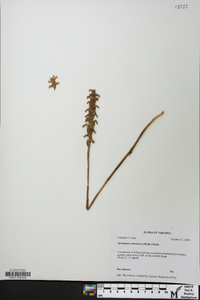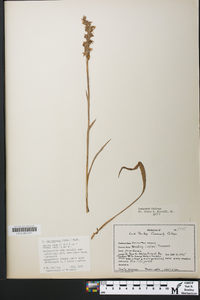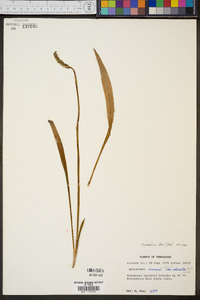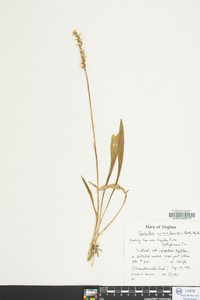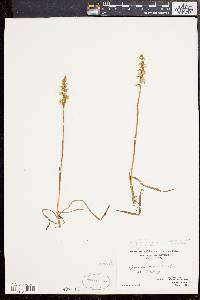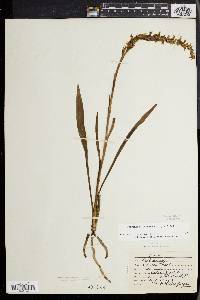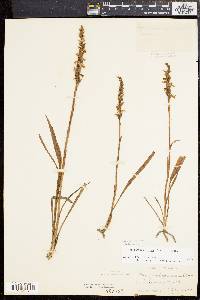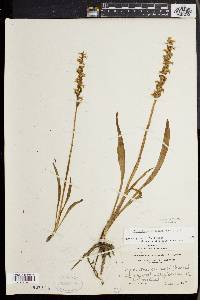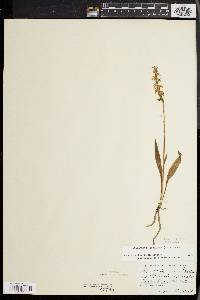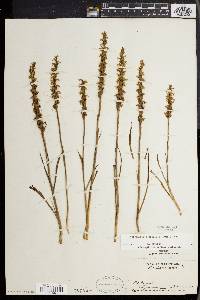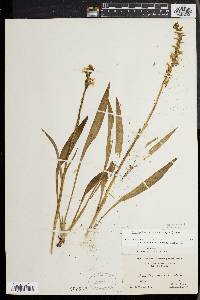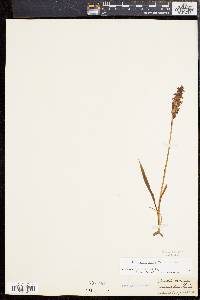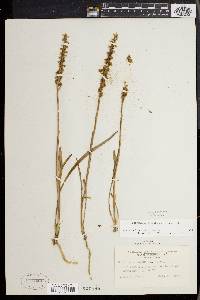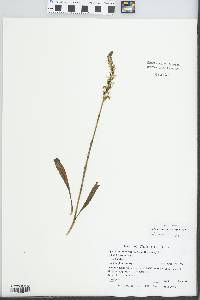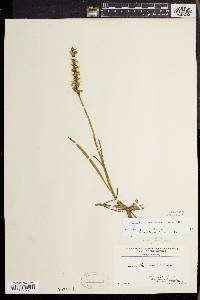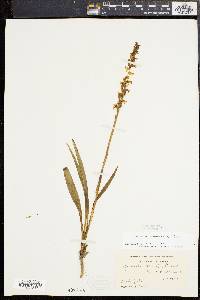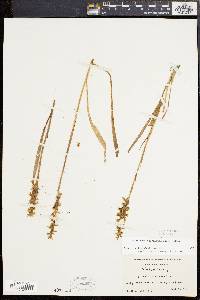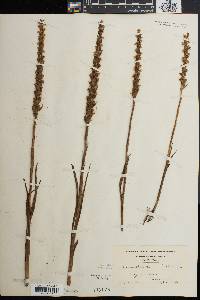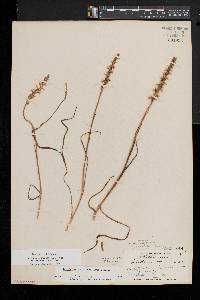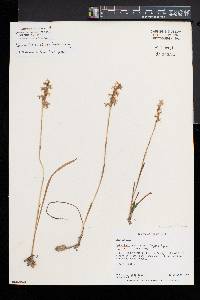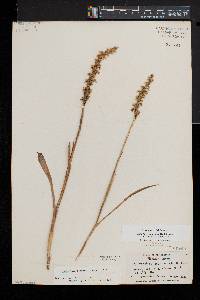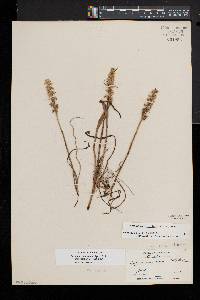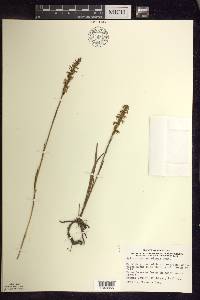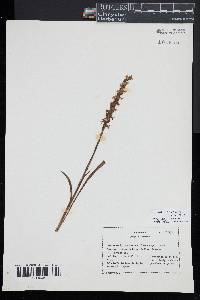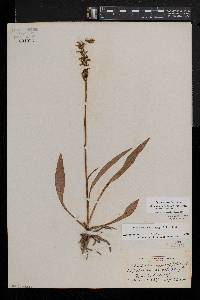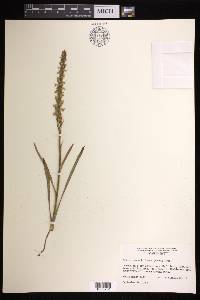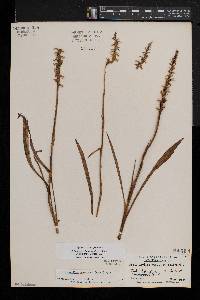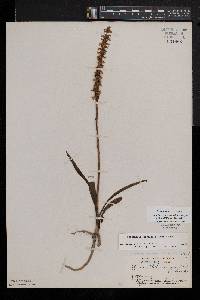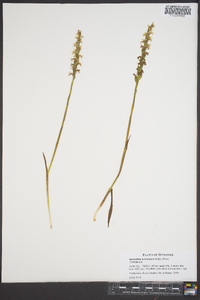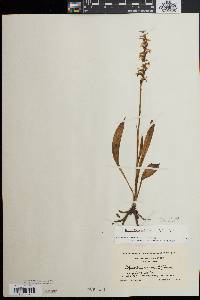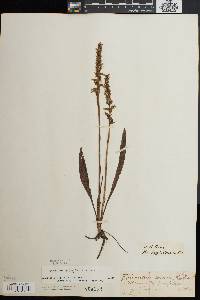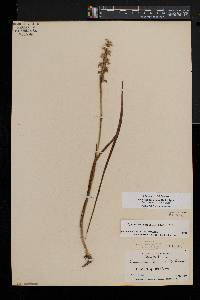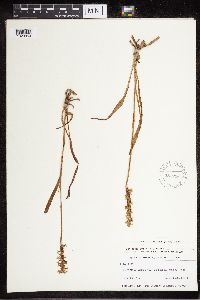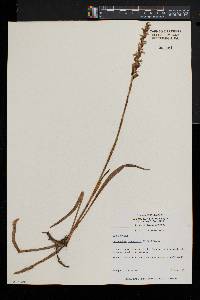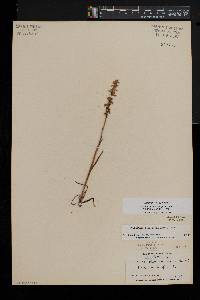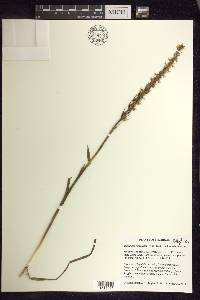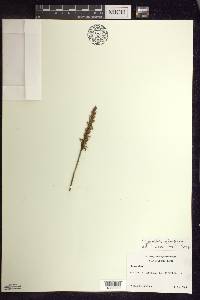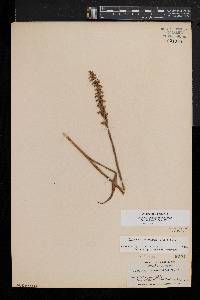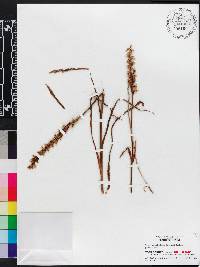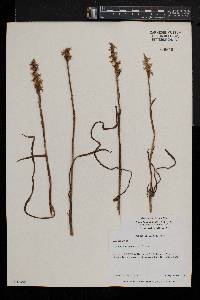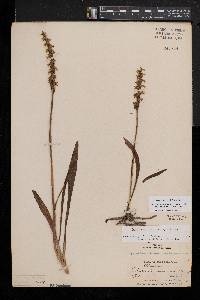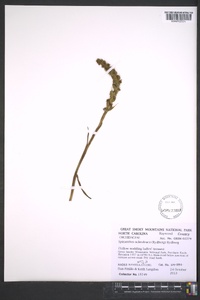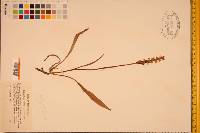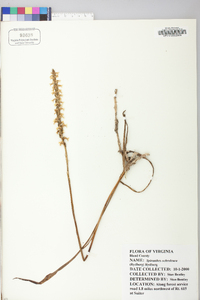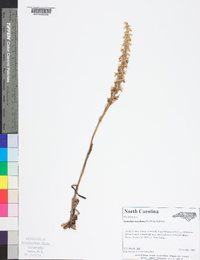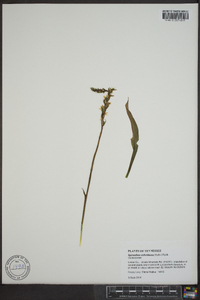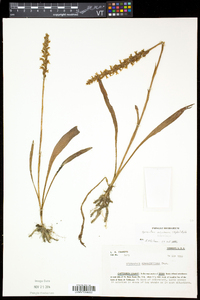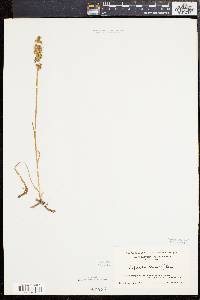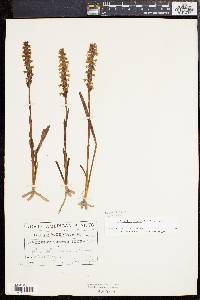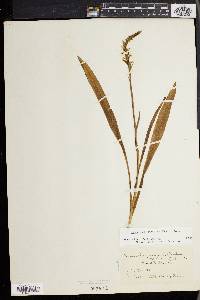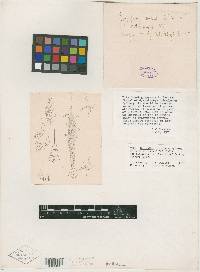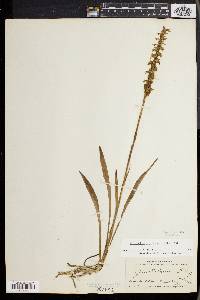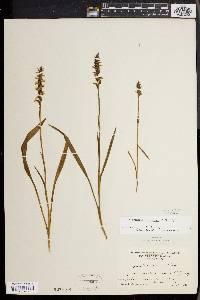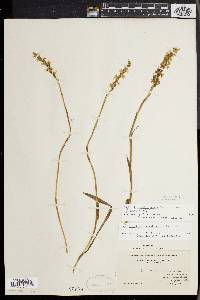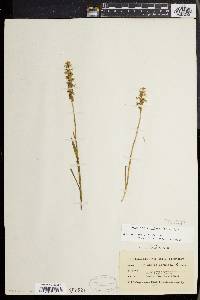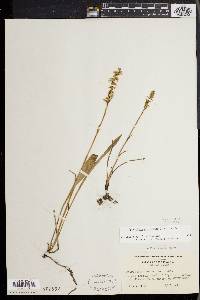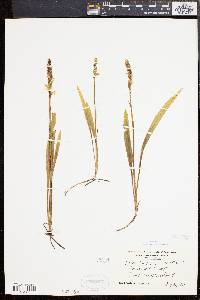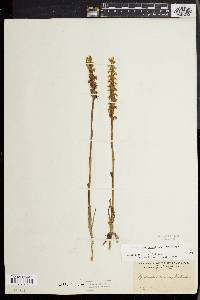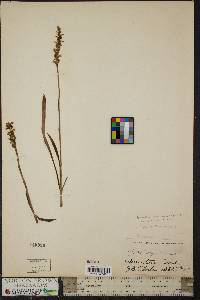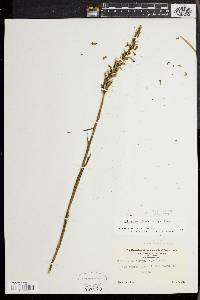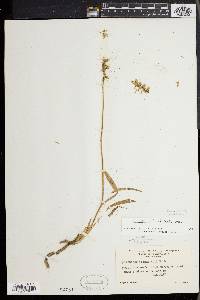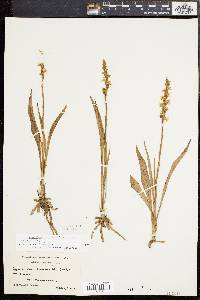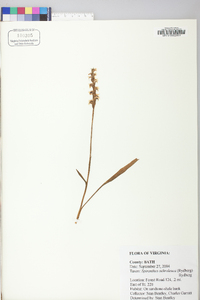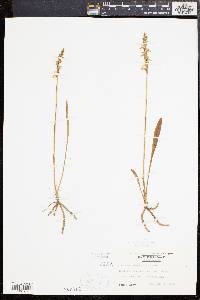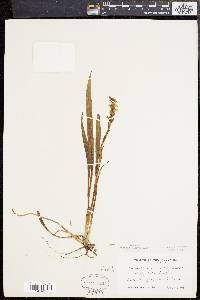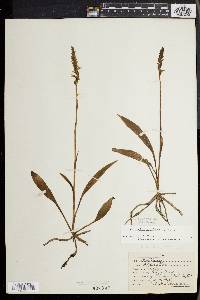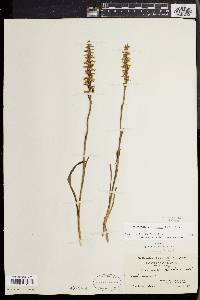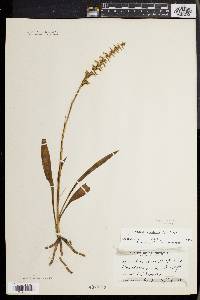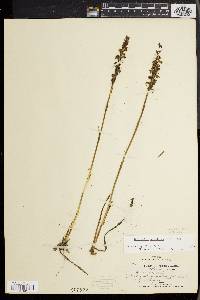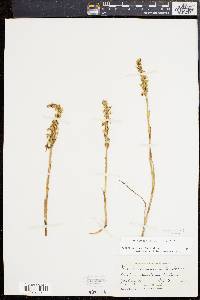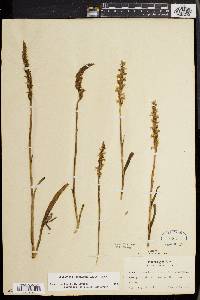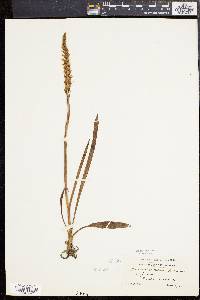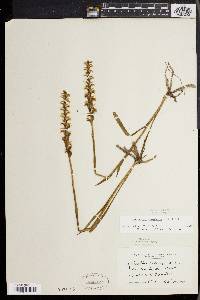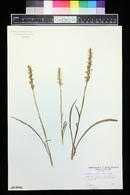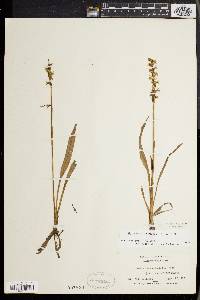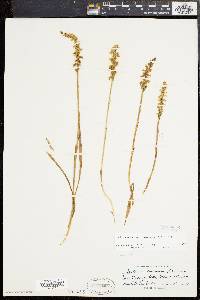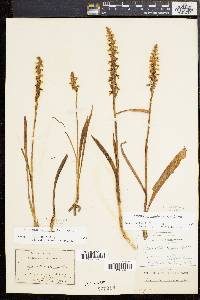
|
|
|
|
Family: Orchidaceae
Yellow Nodding Ladies'-Tresses
[Gyrostachys ochroleuca Rydb.] |
Plants 10-55 cm. Roots few, horizontally spreading, slender, mostly to 0.4 cm diam. Leaves persisting through anthesis, basal, sometimes on basal portion of stem, spreading, linear-oblanceolate to narrowly elliptic, to 21 × 2 cm. Spikes rather loosely to very tightly spiraled, 3-4 flowers per cycle of spiral, occasionally 5 or more in very loose spiral; rachis moderately pubescent, some trichomes capitate, glands obviously stalked. Flowers ochroleucous, ivory, creamy, yellowish, or greenish white, ascending, urceolate to somewhat gaping, claw of lip at pronounced (20-60°) angle to lamina, base cuneate, appearing strongly inflated; sepals distinct to base, 6-14 mm; lateral sepals appressed to petals and lip, straight, separated from dorsal sepal by mostly 0.7-1 mm; petals linear to linear-oblong, 6-13 mm, apex acute to obtuse; lip often more yellow centrally, oblong to ovate, 7-12 × 4-7 mm, margins crenulate, glabrous; veins several, branches parallel; basal calli incurved, prominent, very rarely conic, 1-2 mm; viscidia linear; ovary 3-7 mm. Seeds monoembryonic. 2n = 30. Flowering Aug--Nov. Dry to mesic open woodland, thickets, meadows, barrens, ledges, outcrops, banks and roadsides, old fields; 0--1700 m; N.B., N.S., Ont., P.E.I.; Conn., Ind., Ky., Maine, Md., Mass., Mich., N.H., N.J., N.Y., N.C., Ohio, Pa., R.I., S.C., Tenn., Vt., Va., W.Va. While leaves of Spiranthes ochroleuca are usually present at anthesis, in prairie populations they are commonly absent. Spiranthes × steigeri was described as a hybrid of S. cernua and S. romanzoffiana, but additional study (P. M. Catling 1984) has shown the plants to be referable to S. ochroleuca. See notes on gene flow and apomixis under 14. Spiranthes cernua. Hybrids of Spiranthes ochroleuca with S. casei are known as S. × borealis P. M. Brown.
Perennial herb 10 - 55 cm tall Stem: single, erect, green, hairy (hairs round-tipped), usually only with sheaths most of length. Leaves: three to five, mostly basal, spreading, hairless, non-toothed, 10 - 21 cm long, 0.5 - 2 cm wide, narrowly elliptic to narrow inversely lance-shaped. The leaves usually persist through flowering time, but populations in prairies commonly lose their leaves by flowering time. Inflorescence: a single, erect, terminal, elongate spike of numerous stalkless flowers. The flowers are arranged in a loose to very tight spiral with three to four (sometimes five or mores in very loose spirals) flowers per full turn around the axis. Axis moderately hairy with stalked glandular hairs and round-tipped hairs. Flowers: yellowish white to ivory or creamy (sometimes greenish white), ascending, bilaterally symmetric, about 0.6 - 1.4 cm long (above ovary), urn-shaped to somewhat open-gaping with strongly inflated base (but lacking spur), and curving lip. The reproductive parts of stamens, stigma and style are fused into a column above the 3 - 7 mm long inferior ovary. Sepals: three, petal-like, yellowish to whitish, 0.6 - 1.4 cm long, closely positioned with lateral petals and lip, forward-pointing, and straight, though tips of lateral sepals flare outward 0.7 - 1 mm from central sepal. Roots: few, horizontally spreading, slender (up to 0.4 cm diameter). Lateral petals: two, forward-pointing, closely positioned to sepals and lip, yellowish to whitish, 0.6 - 1.3 cm long, linear to narrowly oblong with pointed or blunt tips. Lip petal: one, central, lowermost, forward-pointing, yellowish (more yellow down center), hairless, wavy-edged, 0.7 - 1.2 cm long, 4 - 7 mm wide, oblong to egg-shaped in outline but with narrowed central section, beyond which tip curves downward at angle of 20 - 60 degrees. There are several parallel-branching veins along the lip, and also two, prominent (1 - 2 mm tall), incurved, basal projections (calli), which are very rarely cone-shaped. Similar species: Spiranthes ochroleuca is most similar to S. cernua, but the flowers of that species are more clear white, the flowers are usually somewhat nodding, the lip petal is more strongly downward pointing, and the calli at the base of the lip are smaller (0.5 - 1.2 mm). Flowering: August Habitat and ecology: Extremely rare, only observed in Berrien County, MI in a moist, open, sandy, mining pit. Occurence in the Chicago region: native Notes: What was once called Spiranthes x steigeri, a proposed hybrid of S. cernua and S. romanzoffiana, was shown by Catling (1984) to actually be S. ochroleuca. Hybrids of S. ochroleuca and the more northern S. casei are named S. x borealis P. M. Brown. Author: The Field Museum |
This project was made possible in part by the Institute of Museum and Library Services [MG-70-19-0057-19].
Powered by Symbiota


